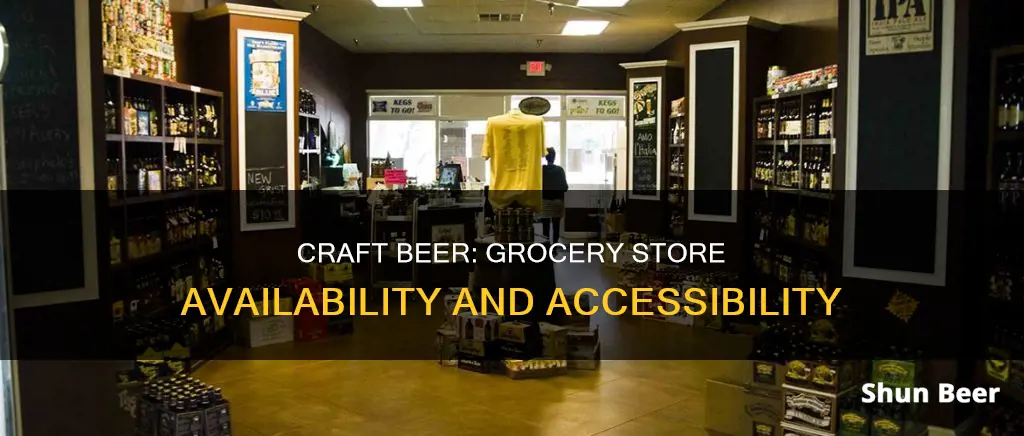
Craft beer is a popular choice for many beer enthusiasts, but can you buy it at the grocery store? The short answer is yes, you can. However, there are a few things to keep in mind when purchasing craft beer from a grocery store. Firstly, it is important to check the freshness of the beer. Look for the bottled-on or best by date to ensure the beer is less than 90 days old, especially for hoppy beers like IPAs. Secondly, temperature plays a crucial role in preserving the flavour of craft beer. It is recommended to buy beer from the refrigerated section whenever possible, as room temperature can accelerate the degradation process. Lastly, consider the reputation of the grocery store when it comes to beer quality. Specialty retailers with knowledgeable staff may offer a better selection of craft beers.
| Characteristics | Values |
|---|---|
| Beer freshness | Beer is best when fresh, especially IPAs and Pale Ales. Check the "bottled-on" or "best-by" date. Avoid beer that is within two months of its "best-by" date. |
| Beer temperature | Beer should be stored in the fridge, especially IPAs. |
| Store type | Specialty retailers are more knowledgeable and passionate about beer. Grocery stores are more likely to stock beer that is old or has been kept at warm temperatures. |
| Brand variety | It is good to try new brands and styles of beer. |
| Beer care | Keep beer in the refrigerator. |
What You'll Learn

Craft beer freshness
When buying craft beer, it's important to consider its freshness. This is because, as Jim Koch, founder of Sam Adams, says, "beer is liquid bread". You wouldn't eat stale bread, so why drink stale beer?
How to Tell if a Beer is Fresh
Many breweries use date codes to indicate when a beer was packaged or when it should be consumed by. However, there is no standard for indicating beer age, and not all breweries use date codes. When they do, they can be hard to find and decipher. Here's how to locate and interpret them:
- Location: Date codes can be printed on the label, the bottle or can, or on the carrier or case packaging.
- Types of Date Codes: The two most common types of date codes are "packaging dates" and "shelf-life dates". Packaging dates indicate when the beer was bottled or canned, while shelf-life dates indicate the date by which the beer should be consumed.
- Reading the Date Code: Packaging dates can be identified by terms like "bottled on" or "packaged on". Shelf-life dates can be identified by terms like "best before" or "enjoy by".
Other Tips for Buying Fresh Craft Beer
- Buy from big businesses: National brands and large craft breweries are more likely to have fresh beer because they have higher sales and need to restock more frequently.
- Talk to the staff: Ask the person in charge of the beer at your grocery store about when shipments come in and which beers they're excited about. They may even have a stash of good beer in the back for interested customers.
- Shop at Whole Foods: Whole Foods has strong relationships with local breweries and distributors and offers an excellent selection of local and obscure beers.
- Avoid mix-your-own six-packs: These single bottles often have inconsistent freshness levels and may have been sitting on the shelf for a while.
- Look for the fridge: IPAs, pale ales, dry-hopped saisons, and other hoppy beers should be stored in the refrigerated section.
Buying Beer in Shelbyville: Sunday Kroger Run
You may want to see also

Beer storage temperature
While buying craft beer at a grocery store, it is important to consider the beer's storage temperature. Beer is typically served and stored at a frigid 38°F (3°C), which is ideal for mass-produced beers as it masks the flavour of cost-saving ingredients. However, for craft beers, this temperature obscures the nuances and complexities of the brew. The ideal minimum temperature for most craft beers is in the low to mid-40s°F (4°C to 7°C). For hearty yeast or hop-forward ales, a slightly warmer temperature is preferable, and for adventurous styles such as lambics or imperial stouts, temperatures can go as high as the upper 50s°F (10°C to 15°C).
When storing beer, it is crucial to maintain a consistent temperature. While some people enjoy cellaring or ageing beer, which involves storing it at a warmer temperature, most beers should be stored cold. The average craft beer has a shelf life of about three months when kept cold, after which it starts to oxidize, resulting in prominent dried fig and cardboard flavours. Additionally, temperature fluctuations can cause oxygen to sneak under the cap and into the bottle, accelerating ageing. Therefore, it is recommended to store beer cold at all times, unless you intend to age it.
When purchasing craft beer, it is advisable to check the "bottled-on" or "best-by" date to ensure freshness. For IPAs, it is best to consume them within a month of bottling, and for other beers, it is recommended to avoid those that are within two months of their "best-by" date.
Buying Beer in Bulk: Is It Possible?
You may want to see also

Where to buy craft beer
When it comes to buying craft beer, there are a few things to keep in mind in order to ensure you're getting a quality product. Here are some tips on where to buy craft beer and what to look for:
Grocery Stores
Grocery stores can be a convenient option for purchasing craft beer. However, there are a few things to keep in mind. Firstly, check the dates on the beer. Look for the "bottled-on" or "best by" date, and try to buy beer that is less than 90 days old, especially for hoppy beers like IPAs. Secondly, buy beer that has been refrigerated. Craft beer is best when it's fresh, and temperature plays a significant role in preserving its flavour. Finally, consider the reputation of the grocery store. Some stores may prioritise moving cases over beer quality. Look for stores that have good relationships with local breweries and distributors, like Whole Foods.
Specialty Retailers
Specialty retailers, such as bottle shops or liquor stores, are often more focused on beer quality than grocery stores. They may have a better selection of craft beers and can provide more personalised recommendations. Additionally, these stores may have more frequent deliveries and fresher stock than grocery stores, which typically only accept new products twice a year.
Online Platforms
With the rise of e-commerce, buying craft beer online is also an option. There are online platforms dedicated to craft beer delivery, offering a wide range of options to choose from. This can be a convenient way to discover new beers and have them delivered directly to your doorstep.
Local Breweries
Supporting local breweries is another great way to get your craft beer fix. You can often find fresh beer directly from the source, and many breweries have taprooms or offer tours where you can learn about the brewing process. Buying directly from the brewery can also be a more sustainable option, reducing the carbon footprint associated with transportation and distribution.
Convenience Stores and Gas Stations
Surprisingly, some convenience stores and gas stations are now offering craft beer options. While the selection may be more limited, it's worth checking out if you're looking for a quick, local option.
Festivals and Events
Attending craft beer festivals or events can be a fun way to discover new beers and connect with other craft beer enthusiasts. These events often feature a wide variety of breweries, giving you the opportunity to sample different styles and chat with brewers directly.
In conclusion, when buying craft beer, it's important to prioritise freshness, quality, and proper storage. While grocery stores can be a convenient option, it's also worth exploring specialty retailers, online platforms, local breweries, and even unexpected places like gas stations. By diversifying your sources, you can discover new beers and support the craft beer community.
Buying Beer in California: Grocery Store Rules Explained
You may want to see also

Brand awareness
Understanding the Market and Consumer Behaviour
Craft beer brands need to recognize that consumers' purchasing decisions in grocery stores are often influenced by brand familiarity and trust. Shoppers are more likely to choose a craft beer they have heard of or seen before, especially if they are not craft beer enthusiasts. Therefore, building brand awareness and recognition is essential to boost sales in this setting.
Emphasizing Quality and Consistency
Craft beer brands must ensure that their product is of exceptional quality and consistent across batches. This means investing in the brewing process, selecting the finest ingredients, and implementing rigorous quality control measures. By delivering a superior and reliable product, craft beer brands can establish a positive reputation and earn the trust of consumers, leading to increased brand awareness and loyalty.
Effective Branding and Packaging Design
In a crowded market, eye-catching and distinctive branding and packaging design are pivotal to making a craft beer brand stand out. The design should be visually appealing, unique, and reflective of the brand's identity and values. It should also effectively communicate the beer's style, flavor profile, and any unique selling points to differentiate it from competitors.
Leveraging Marketing and Storytelling
Craft beer brands should invest in professional marketing strategies and compelling storytelling to create a strong brand image and connect with consumers. This includes developing an engaging brand narrative, utilizing various marketing channels, and leveraging digital platforms to reach a wider audience. By creating a distinct brand identity and sharing their story, craft beer brands can foster emotional connections with consumers, leading to increased brand awareness and loyalty.
Collaborating with Distributors
Distributors play a crucial role in getting craft beer brands onto grocery store shelves. It is essential to select a distributor with a strong track record and extensive knowledge of the market. Craft beer brands should seek distributors who understand their unique selling points and are committed to promoting their products effectively. Building a solid relationship with distributors can help craft beer brands gain access to valuable retail spaces and increase their brand's visibility.
Focusing on Freshness and Shelf Life
Given that craft beer is highly susceptible to staleness and flavor degradation over time, ensuring a short shelf life and emphasizing freshness are critical. Craft beer brands should implement measures to maintain the quality of their product throughout the distribution process, such as proper storage and transportation conditions. Additionally, providing clear "best before" dates on the packaging helps consumers make informed purchasing decisions and ensures they enjoy the beer as intended.
By implementing these strategies, craft beer brands can effectively enhance their brand awareness in the competitive grocery store landscape, ultimately driving sales and establishing long-term success.
Retailers' Freedom to Buy Beer Outside of Exclusive Contracts
You may want to see also

Distributor relationships
Craft beer distributors are often family-owned, small businesses that have strong relationships with local breweries and grocery stores. They understand the unique needs and preferences of their local market and can provide valuable insights to both breweries and retailers. Distributors are responsible for ensuring that the beer is stored and transported properly, maintaining its quality from the brewery to the store shelf.
To build successful distributor relationships, craft beer producers should consider the following:
- Understanding the Distributor's Business: Getting to know the distributor's business model, their other brand partners, and their sales and distribution network will help craft beer producers align their goals and strategies with the distributor's capabilities.
- Clear Communication: Open and honest communication is key. Craft beer producers should clearly communicate their expectations, sales targets, and marketing plans to distributors. Similarly, distributors should provide feedback on market trends, consumer preferences, and sales performance.
- Collaborative Marketing: Working collaboratively with distributors on marketing and promotional activities can increase the visibility and sales of craft beer in grocery stores. This may include providing point-of-sale marketing materials, staff training, and participating in tasting events or promotions within the store.
- Flexibility and Adaptability: The craft beer market is dynamic, with consumer preferences and trends evolving rapidly. Both producers and distributors need to be flexible and adaptable to meet changing demands. This may include adjusting production volumes, distribution routes, or packaging formats to suit the needs of the grocery store and its customers.
- Relationship Building: Distributors value long-term relationships with craft beer producers. Producers should focus on building trust, treating distributors as partners, and providing support beyond just the product. This may include joint marketing efforts, staff training, and attendance at industry events or promotions.
- Quality Assurance: Craft beer producers should ensure that the quality of their product is consistently high. Distributors will be more confident in promoting and selling a craft beer if they know that the quality is reliable and will not lead to customer complaints or returns.
By fostering strong distributor relationships, craft beer producers can increase their chances of securing shelf space in grocery stores and successfully reaching their target consumers. These relationships are built on communication, collaboration, and a shared commitment to bringing high-quality craft beer to market.
Buying Beer on Christmas Day in North Carolina
You may want to see also
Frequently asked questions
Yes, you can buy craft beer at the grocery store. However, it is recommended that you buy craft beer from specialty retailers that have the knowledge and passion for beer.
Most craft beer bottles or cans will have a "bottled-on" or "best-by" date on the bottom or side. Generally, you want beer that's less than 90 days old, and if you're buying hoppy beer, the fresher the better.
Yes, as a general rule, you should never buy an IPA that has been stored at room temperature. If you do, you’re disrespecting the IPA’s flavor at the highest level.
Some craft beer options that you may be able to find at the grocery store include Bell's Two Hearted Ale, Sierra Nevada Pale Ale, and Anchor Steam.







